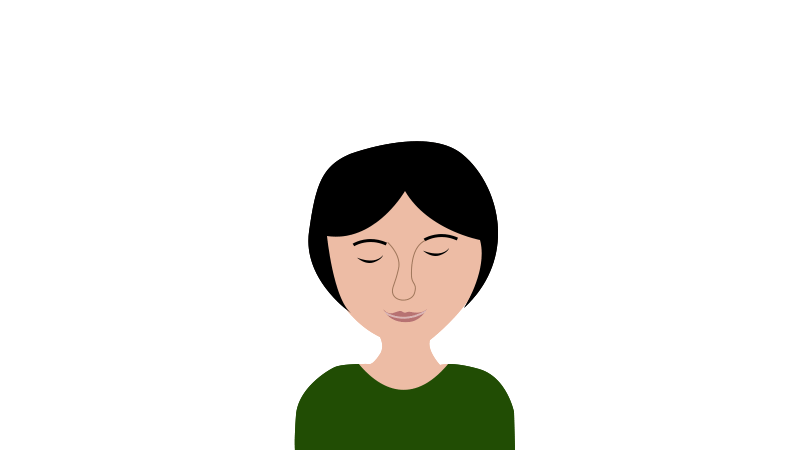
Chandra Bhedana Pranayama is a cooling breathing technique of yoga in which air is inhaled through the left nostril and exhale through the right nostril. It’s a type of uninostril breathing where inhalation and exhalation are limited to the left and right nostrils respectively.
According to yogic science, the left nostril is attached to the ‘Chandra’ or ‘Ida Nadi’ that exists along the spinal column. Nadis, in general, are the energy channels spread throughout our body to flow the prana (life force) in different organs. Breathing in Chandra bhedana pranayama affects the flow of Prana in Chandra Nadi, so it’s also called Chandra Nadi Pranayama.
The benefits of Chandra bhedana pranayama come from its mechanism of inducing ‘left side of the body’ and ‘right hemisphere of the brain’. Inducing the right brain hemisphere activates the Parasympathetic nervous system and brings a calming and soothing effect to the body.
What Does Chandra Bhedana Pranayama Meaning?
Chandra in Sanskrit means ‘moon‘ or ‘lunar aspect’ and Bhedana means ‘piercing‘ or ‘penetrating’ something. Chandra Bhedana Pranayama literally means “moon piercing breathing”. In this pranayama, by emphasizing breathing through the left nostril only we penetrate (Bhedana) into the Ida Nadi. This Nadi represents the Moon-like calming and soothing quality in our body. It’s also called ‘Chandra Bhedi Pranayama’.
Breathing in Chandra Bhedana Pranayama increases the coolness in the body because on inhalation, the air is filled with cooling energy of Ida Nadi and moreover, on exhalation, hotness of the body is exhaled from the right nostril. Therefore this pranayama is also named ‘left nostril breathing’.
Chandra or moon also governs the feminine and creative aspects of a person. So practicing Chandra bhedana is beneficial when you’re stressed, need creative ideas, lacking imagination, passion, and interest in your work. It imparts a tranquilizing effect on the mind and handles cognitive functions such as attention, processing of visual shapes, patterns, emotions, verbal ambiguity, and implied meanings. All these aspects are governed by the right brain only and Left nostril breathing activates the right brain hemisphere.
Precautions and Contraindications
Chandra Bhedana Pranayama should not be practiced in the condition of asthma, low blood pressure cough, or any other respiratory disorders. Also, it should be avoided practicing much during winter sessions or on a cool day. Practitioners should not eat right before and after the practice of this Pranayama.
It’s not recommended to practice Chandra Bhedana pranayama practice just after or before the Surya Bhedana Pranayama. Opposite pranayama may neutralize the effects of one another. However, combining these two pranayamas in one practice makes Nadi Shodhana Pranayama which balances both brain hemispheres.
How to Do Chandra Bhedana Pranayama (Steps)

You can perform Chandra Bhedana Pranayama on a yoga mat, carpeted floor, or soft surface. Sitting on a chair is also fine for a person with knee pain or other problems. However, keeping the body in direct contact with the earth will enhance the breathing effect.
Follow the steps to perform chandra bhedana pranayama;
- Begin by coming into any seated meditative posture; easy pose or lotus pose. Straighten your back, eyes closed, and focus on the tip of your nostril watching breath coming in and out.
- Now relax your left hand on your left kneecap and make Vishnu Mudra with your right hand.
- Bend your right hand and lift it up near the nostrils. Close the right nostril with the right thumb so you can only breathe in through the left nostril.
- Begin the first round of Chandra Bhedana by taking a deep breath through the left nostril, filling the chest to the fullest capacity. Feel the cooling sensation in nostrils and brain as breath becomes deeper here.
- After deep inhalation, close the left nostril with your right ring finger and begin ‘breathing out’ through the opposite (right) nostril. Feel the warmness in the air that is coming out through the right nostril.
- It completes the one round of Chandra bhedana pranayama.
- In this same manner, breath in through the left nostril and breath out through the right nostril.
- Repeat the process 10 times in one stretch. You can do Chandra bhedana pranayama for 5 minutes during the daytime in summer.
- After completing, release the right-hand mudra first, remain in the same sitting position for a few breaths, and then stand up.
Time of Practice
It is necessary to know the right time to practice Chandra Bhedana Pranayama as it brings coolness, so to avoid disturbance in the body’s metabolism outer environmental conditions should be in sync.
During summer, Chandra Bhedana is better to perform in the early morning or on Brahma Muhurta. Because the sun rises early in summer and this is the time when sunlight is fresh and is of low intensity.
However during winter, due to the cold outer environment, early morning practice of Chandra bhedana pranayama might be difficult in the open. So, the practitioner can wait for the right environmental conditions to practice in open or when the sun comes.
Chandra Bhedana Pranayama Benefits
The practice of Chandra Bhedi Pranayama has numerous benefits from physical, mental to emotional health. It can be especially beneficial in some physical condition like controlling blood pressure, heartburnrn, fever, etc.
Therapeutic Use
- Slow and deep breathing in Chandra Bhedi Pranayama helps in the activation of the Parasympathetic Nervous System, which reduces heart rate and dilates blood vessels. Hence, decreases overall Blood Pressure.
- The shift in breathing from Chest to belly or Diaphragm in Chandra Bhedi Pranayama helps in overcoming heartburn. When LES (Lower Esophagus Sphincter) becomes weaker acid from the stomach is more likely to splash into the esophagus (food pipe) where it causes Heartburn.
- It also helps in reducing raised body temperature due to the body’s defense mechanism against foreign agents like viruses and bacteria. Hence, Chandra bhedana acts as a therapeutic remedy in Fever.
Apart from therapeutic use, Chandra bhedana pranayama benefits the body and mind in such ways;
1. Manages Immune and Metabolic Response
Chandra Bhedi Pranayama involves slow and deep breathing, which rushes more oxygen into the body. This signals the brain to wind down and balances the cortisol hormone level responsible for maintaining immune and metabolic responses throughout the body.
2. Overcomes Stress and Anxiety
Any stimulus that disturbs the balance between mind and body gives rise to stress, which causes unnecessary hyperactivity in the body. However, according to one of the research on college students, it has been found out that there is a significant reduction in the mean value of stress level taken before and after the test on the practice of Chandra Bhedi Pranayama.
3. Improves Blood Circulation
Slow and deep inspiration while practicing Chandra Bhedi Pranayama increases the pressure gradient between the right heart and systemic circulation due to a decrease in intrathoracic/intrapleural pressure being transferred to the right atrium. Hence, an increase in venous return, which fills the right atrium and right ventricular strokes volumes.
4. Improves Respiratory Efficiency
According to one of the studies, there is a significant improvement in pulmonary function tests such as Forced Vital capacity (FVC), Peak expiratory flow rate (PEFR), Forced Expiratory Flow (FEF 25-75%), and Maximum Voluntary Ventilation (MVV). Hence, the regular practice of Chandra Bhedi Pranayama increases respiratory efficiency. Moreover, it has beneficial effects on the respiratory and cardiovascular system when practiced regularly.
5. Activates Ida Nadi
In Chandra Bhedi Pranayama, the left nostril is used to breathe air inside. This is also the point through which the Ida Nadi runs. Hence, the breathing stimulus of the Ida Nadi in this pranayama and provides calmness of mind and body along with coolness throughout the body. Moreover, it also helps in the activation of Sushumna Nadi residing in the center, along with Pingala Nadi runs through the right nostril.
6. Synchronized Brain Waves
Regular practice of this pranayama improves and controls the subtle phenomenon of the brain. This brings to mind and body in synchrony through breathing. However, as per studies, it has been found out that Chandra Bhedi Pranayama helps in shifting the frequency count, which leads to consciousness of the human brain through the attainment of the higher cognitive states.
Conclusion
The Chandra Bhedi Pranayama is effective yogic breathing, which tranquilizes the mind and body by its cooling effect through Ida Nadi. However, it is also helpful in treating heartburn and also helps in reducing body temperature.
Due to the synchronized effect of the brain’s hemisphere, it heightens the awareness of the practitioners, which further leads on to a spiritual path. Hence, practitioners should regularly practice refining their Prana in every aspect .





A very useful pranayam. Since I am elderly senior and have never attended any yoga Pranayama camp. Further Part of my right lung is non-functional due to thoracoplasty. Will it be advisable for me to start this pranayama?
As you seem a total beginner in pranayam and you have a health condition too, I will not suggest you do it your own. Please join a yoga class where an expert teacher can check on you and guide you in person.